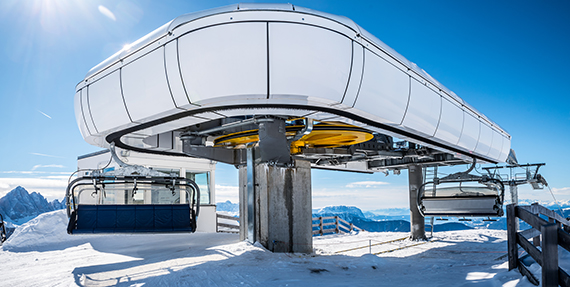Skiing in Alaska: Epic Resorts, Backcountry & Heli-Ski Adventures
For those who dream of carving turns through bottomless powder, skiing under the Northern Lights, or experiencing true wilderness on skis, Alaska is your ultimate winter destination. Here's a closer look at the diverse types of skiing experiences you can have across the state.
The Diverse Skiing Opportunities in Alaska
Compared to other locations, Alaska is more of a skiing pilgrimage defined by its dramatic landscapes, where mountains plunge into the sea and impossibly deep snow makes the word "epic" feel like an understatement. Its unique geography creates a spectrum of experiences, from accessible resort steeps to the planet's most extreme big-mountain adventures, catering primarily to advanced enthusiasts who seek the highest peaks and the deepest snow.
-
Alpine (Resort) Skiing
Alpine skiing is a form of downhill skiing done on steep resort slopes. The skier's heel is locked down onto the wide, stiff skis, allowing gravity to provide the speed. It's an adrenaline-focused activity that uses lifts to get you up the mountain.
Alaska's ski resorts are legendary for their steepness, abundant snow, and stunning coastal views. Here are two popular spots that serve as perfect warm-ups for bigger adventures.
- Alyeska Resort (Girdwood): The undisputed king of Alaskan resorts. Nestled in the Chugach Mountains, Alyeska features a 2,500-foot vertical drop and averages over 650 inches of annual snowfall at upper elevations. It's famous for its challenging steeps, open bowls, and panoramic views of the Turnagain Arm. Girdwood itself offers excellent lodging and après-ski experiences.Fun Fact: Alyeska is home to North America's longest continuous double-black-diamond run, "The North Face," a legit test of endurance and skill.
- Eaglecrest Ski Area (Juneau): A community-owned gem known for its ocean views, deep snow, and easy access to backcountry terrain right from the lifts.
-
Cross-Country (Nordic) Skiing
Nordic skiing, or cross-country, is about gliding across flat or rolling terrain using only your own power. The skier's heel is free from the long, narrow ski, enabling a walking or striding motion. It is a full-body, endurance-focused workout for exploring natural landscapes. Cross-country skiing is part of Alaska's winter identity. It's transportation, recreation, and a form of meditation all in one.
The Experience: Alaskans embrace both classic-style skiing (in parallel tracks) and the faster, more dynamic skate skiing.
Prime Locations: Anchorage offers an award-winning trail network, including Kincaid Park, which hosts international competitions. In Fairbanks, Birch Hill Recreation Area often provides the surreal experience of gliding beneath awe-inspiring auroras.
Cultural Connection: For many Alaskans, Nordic skiing isn't just a hobby; it's a way of life. The vast number of groomed trails reflects the state's deep commitment to winter endurance sports.
-
Heli-Skiing
For expert skiers, heli-skiing in Alaska is the pinnacle. Imagine being dropped by helicopter onto a remote, towering peak in the Chugach Mountains, then descending thousands of vertical feet through untracked snow. This is what defines Alaskan skiing for the world: untouched powder as far as the eye can see, accessed by a dramatic drop from a helicopter.. This is big-mountain skiing at its purest and most demanding.
The ranges around Valdez and Haines are world-renowned for their deep, stable snowpack and jaw-dropping terrain. For visitors, this isn't a casual vacation; it's an expedition, a pilgrimage into the wild. Many of the most iconic scenes in ski and snowboard films are shot in the Alaskan Chugach, cementing its legendary status among professional athletes.
Fun Fact: The Chugach Mountains rank among the snowiest in the world, with massive annual accumulations. Certain areas, particularly near the coast, can receive as much as 1,250 inches (over 100 feet!) annually.
-
Backcountry Skiing (Alpine Touring/Ski Mountaineering)
Backcountry skiing offers the same wild spirit with an added sense of accomplishment. Using touring gear and "skins" for traction, skiers ascend under their own power. Popular zones like Turnagain Pass (near Anchorage) and Hatcher Pass offer endless bowls, glades, and peaks. Ski mountaineering elevates this pursuit further, often involving glacier travel, ropes, and ice tools to reach technical summits.
More On Alaskan Ski Culture
Who are the skiers drawn to Alaska?
The Locals: Alaskans live and breathe winter. They're resilient, versatile, and skilled across all skiing disciplines, from resort runs to remote backcountry tours.
Thrill-Seekers & Professionals: Elite skiers, snowboarders, and filmmakers come here for the legendary heli-skiing and massive terrain. Alaska is where the boundaries of the sport are continually pushed.
How many ski areas are there in Alaska?
Alaska has a mix of large resorts, smaller local hills, and military-run areas. Most commonly, Alaska is cited as having seven major public ski resorts (or "ski areas") where you can buy a lift ticket. If you include all public, non-profit, and military-run ski hills, the number can be as high as 18.
These include the major ski destinations like:
- Alyeska Resort (near Anchorage/Girdwood) - The largest resort in the state.
- Eaglecrest Ski Area (Juneau)
- Arctic Valley Ski Area (near Anchorage)
- Moose Mountain (Fairbanks)
- Ski Land (near Fairbanks)
- Hilltop Ski Area (Anchorage)
- Mount Eyak Ski Area (Cordova)
Tips For Planning Your Alaskan Ski Adventure
- Best Time to Go: The ski season typically runs from late November to April, but the prime months for deep powder and daylight are February through early April. For heli-skiing, the sweet spot, balancing stability, snow depth, and daylight, typically runs from mid-March to mid-April.
- Heli-Skiing Is the Ultimate Commitment: If your budget and skill level allow, book early with reputable operators in Valdez or Haines.
- Safety Is Non-Negotiable: If you're venturing into the backcountry, avalanche gear (beacon, shovel, probe) is mandatory. Complete a certified avalanche safety course (AIARE 1) before you go.
- Hire a Guide: For serious backcountry or ski mountaineering missions, certified local guides can help you find the best snow and navigate Alaska's complex snowpack.
- Train Before Going: Deep-powder skiing and long runs demand serious leg strength and endurance. A bit of preseason training pays off.
- Prepare for Cold and Darkness: Quality layering is key. Early-season days (December and January) bring ethereal "blue light" conditions, while later months offer long, golden days of skiing.
Is Alaska calling you this winter? If so, gear up, strap in, embrace the challenge, and discover the most magnificent ski frontier on Earth.
5 Additional Planning Resources:
https://www.skiresort.info/ski-resorts/alaska/
https://www.alaska.org/things-to-do/ski-areas
https://alaskabackcountryguides.com/
https://www.travelalaska.com/explore-alaska/articles/alaska-top-ski-destination






